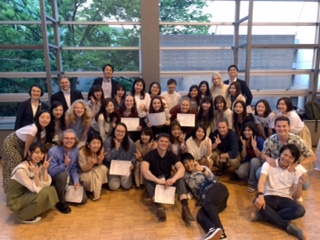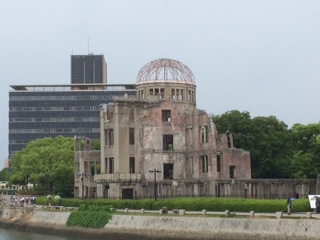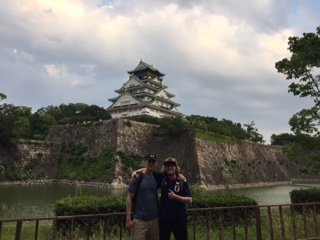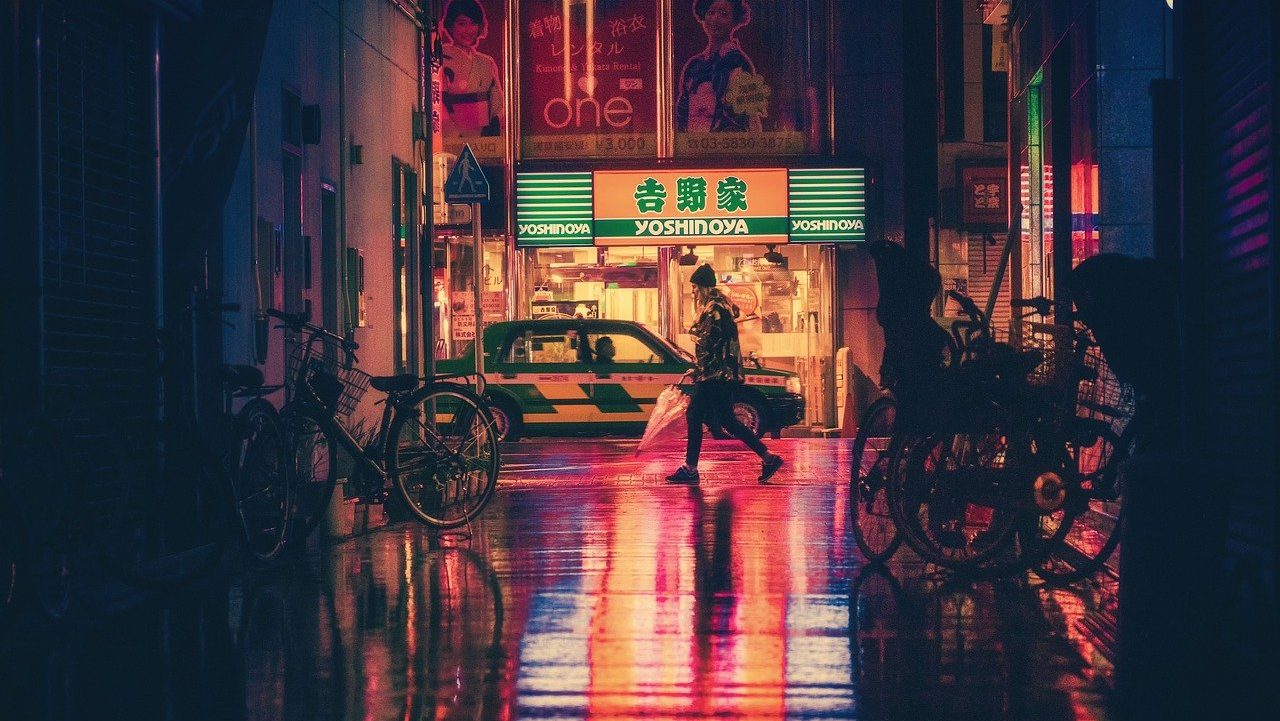Hope History Major Brennan Church (Class of 2020) reflects on his trip to Japan during a 2019 May Term.

This past summer, I participated in the 2019 Japan May Term Program along with eleven other Hope students and two faculty leaders. I was very enthusiastic about exploring Japan, as this was my first time to Asia. I was anxious to see all the beautiful temples, taste the abundance of delicious food, and, of course, test out my two semesters of Japanese.
For three weeks my companions and I stayed in Tokyo where we attended classes at Meiji Gakuin University. The classes focused on various Japanese topics ranging from traditional Japanese theatre (called “Kabuki”), to the business environment in Japan, to the ninja, to Japanese pop music, and to the baking of Japanese sweets called “Wagashi.” To my delight, these classes were frequently followed by field trips to observe firsthand. My favorite excursions were to the Tokyo Sumo Championship and a professional baseball game.

Meiji Gakuin was a gracious host. We were paired with several Japanese student volunteers who were more than excited to share their city with us. Most days I only had one class, which provided me with plenty of time to explore Tokyo with my new friends!
Tokyo is so technologically advanced that some parts of it feel like you’re in the next century. Motorized carts in certain restaurants bring out your sushi seconds you order. Trains are always on time, fast, and silent. No space goes unused. Shops and restaurants have taken up residence even under the street, forming an underground world of sorts. Everything is immaculately clean, and don’t even get me started on the restrooms.
In beautiful contrast to the high-tech urban scene are gorgeous traditional Shinto shrines and the frequent festivals where it’s common to see people wearing kimonos. I was shocked to learn that awe-inspiring buildings like the Tokyo Imperial Palace and Tokyo’s famous Sensoji Temple had been destroyed in WWII because the reconstructions look as if they’ve stood there for centuries.

While Tokyo is the most populous city in the world, getting around is surprisingly easy! There are almost always signs in English, and it’s rare not to find a subway entrance nearby. People are so orderly in Japan, too! They always keep to one side on walkways and escalators, which assisted me in the subway on days when I was in a time crunch to make it to class.
Although I knew that Japan and the U.S. had been on friendly terms since the end of the post-WWII American occupation in 1952, I had expected there to still be some bitterness toward Americans. However, the complete opposite seemed to be true based on my interactions with the Japanese. They seem to adore American culture, including its music, food and clothing brands, and sports. Many young Japanese desire to learn English, and I tried my hand at teaching a little to my newfound friends and host family.
People in Japan show great respect to all foreigners, and they are so polite! For example, when my class took the shinkansen (bullet train) to western Japan, the train staff bowed to the passengers in each car regardless of the nationality of those in the car. I was surprised by this gesture because the staff had no reason to show me such respect, yet they did!
An important aspect of Japanese culture is service to others. Both at Meiji Gakuin and at my homestay, everyone was very accommodating and planned their day around what I wanted to do, which was often visiting temples, castles, and singing karaoke. Karaoke is so popular in Japan that there are buildings dedicated to just karaoke! At these locations, people rent a room for just their group so singing is unintimidating, and the song selection to choose from is extensive and multilingual. One day my friends and I even went to Tokyo Disneyland! Conversing in Japanese with locals and going on adventures with Japanese students was truly the highlight of my time in Japan.
I found that Japanese people are more than helpful if you ask. One time I found myself lost in the Shinagawa district of Tokyo while I was going to meet my friends for a yakiniku (Japanese barbeque) dinner, so I stopped inside a nearby office building and asked the receptionist if she could point me in the direction of the restaurant. Instead of simply telling me, the employee got up from her desk and walked with me all the way to the restaurant. How kind!
My homestay took place east of Tokyo in Chiba Prefecture. I was hosted by the Kanazawa family of Matsudo, who were wonderful to me. Much of my time with them was spent away from their house; instead, we were at their ancestral home in Tateyama. I assisted them in cleaning up their ancestral gravesite. This was followed by a picnic in a bamboo forest nearby and my first visit to an onsen (a public bath). I found the onsen to be awkward initially, but once I got over my nerves, it was relaxing.
The Kanazawas and I returned to Matsudo. My host sisters showed me around their town and their school. I began to realize what it felt like to be a minority. Matsudo and Tateyama were small cities, and as far as I could see, I was the only non-Japanese person in either of them. This made me appreciate more what life must be like for people of color in the U.S. Much to my displeasure, the homestay was only for a weekend, which was not nearly long enough. My host family treated me to a sukiyaki dinner (beef and vegetables dipped in raw egg), a dish I highly recommend.
Back in Tokyo, our program concluded after each of the Hope students presented their research on Japan. I presented on the unification of Japan and the legacy of the Tokugawa Shoguns. Then my fellow travelers and I embarked on our weeklong expedition around western Japan, passing through Kanazawa, Kyoto, Kobe, and Hiroshima.
Kanazawa, a city that bears the same name as my host family, is a very small city and a former samurai fortress town. Kyoto is a paradise for any person interested in Japanese history. There seem to be too many ancient structures there to count, as Kyoto was the only major city spared from the American air raids. Most of these structures are accessible to the public. My favorite was Fushimi Inari, a shrine that includes a wonderful mountain hike, but foot traffic is heavy.

Taking a day to see Nara, Japan’s first capital, is also enjoyable. Todaiji Temple won’t disappoint; it’s magnificent. Just watch out for the deer in Nara; they tried to eat the clothes off my back when I ran out of food! Next, we briefly stopped in Kobe, a city famous for its savory steaks. They are expensive but well worth it. We met some local students at Kobe Gakuin before making our way south to Hiroshima. The shinkansen truly are the best way to travel in Japan; they’re incredibly comfortable and never have to stop for cars, as they operate on a completely different track system. Japanese engineering is marvelous.
I found Hiroshima to be deeply thought-provoking. The streets were far less active than cities I’d visited previously. We saw the Genbaku Dome, the last standing structure to survive the bombing. Then we moved onto the memorial and museum which included many firsthand accounts of the atomic bombing. This experience made me acutely aware of the tragic results of war and the effect of atomic weapons. How well the city is rebuilt today really speaks to the work ethic of the Japanese people. If one had no knowledge of the bombing, one would never know it had happened.

After Hiroshima, we returned to Tokyo for the final portion of the May term. We reconnected with our Meiji Gakuin friends who kindly took us to the fireworks festival in nearby Yokohama! Soon after, my Hope friends, my new Japanese friends, and I went our separate ways, but I know I’ve made some friendships for life. I returned to Tokyo’s Narita Airport, not to leave, but instead to meet my father, who had taken time off to come visit me!
Showing Japan to my Dad was the ultimate bonding experience! I got to impart all the knowledge I’d gained in my month-long tour, really impressing my Dad with how much I’d grown while away. He’d never heard me speak Japanese before then, so with me acting as our translator, his pride was over the moon.
The two of us traveled around for an additional week after the May term. I wanted to give my Dad the complete Japanese experience, so we hit four cities in seven days. Each day, I exposed him to a different Japanese food. One delicacy any traveler to Japan should be sure to try is okonomiyaki (Japanese omelet); it’s exquisite!
I showed him Tokyo, which I’d become skilled in traversing by that point. Next, we headed to Tokyo station to catch the shinkansen to Nagano. However, we got disoriented in the terminal after our tempura lunch (breaded and fried food), which almost led to us missing our train. We bolted across the platform and made it onto the train right before the doors closed… Imagine the scene in Indiana Jones where the hero slips through the closing temple door right before it shuts.

Nagano is a mountain settlement famous for hosting the 1998 Winter Olympics, something the people there are still very proud of. We stayed at a ryokan (a traditional Japanese inn), which looked like a home from the Tokugawa-era (1600-1867). Our ryokan hosts were so friendly; they provided us with two gourmet Japanese-style meals a day and any supplies we needed. They even drove us all the way back into Nagano city from the mountains so we didn’t have to catch the bus! The man who owned our ryokan was a Shinto priest. He invited us to sit in on his service in a nearby mountain-top shrine. It was the most incredible, authentic experience of my trip!
However, I was motivated to visit Nagano, not for the ryokan, but for the snow monkeys. We hired a guide to show us the national park close to the city where visitors can come face to face with the red-faced, white-furred monkeys. I loved every second of it! Before leaving Nagano, we took another hike because this place was gorgeous! We trekked through the forests and villages, finding various shrines as we went, and stopped for soba noodles on the road. There were bears around the area of our hike, but we were undeterred. Nagano is a fabulous get away from the city.
We closed out our adventure with a return trip (for me) to Kyoto. The two of us briefly attended a samurai school in Kyoto, but I wouldn’t recommend it. Then we caught a shinkansen bound for Osaka. Osaka is a prominent port city and renowned for its food culture. It seemed to me like everywhere I went I’d see a takoyaki (octopus dumplings) restaurant. We rented bikes and rode through the city’s crowded streets, sometimes going faster than the cars, and other times at a snail’s pace. We made a stop at Osaka’s most impressive structure, the imposing Osaka Castle. Today the castle is a museum, so one can walk through most of it. The view is amazing! The following day, we made the journey back to Tokyo for the homeward leg of the trip.
This May term opened my eyes to the cultural wealth Japan has to offer. It inspired me to continue my Japanese language studies with even more vigor! I’m eager to return to Japan and motivated to experience other parts of Asia.
– Brennan Church (Class of 2020)


